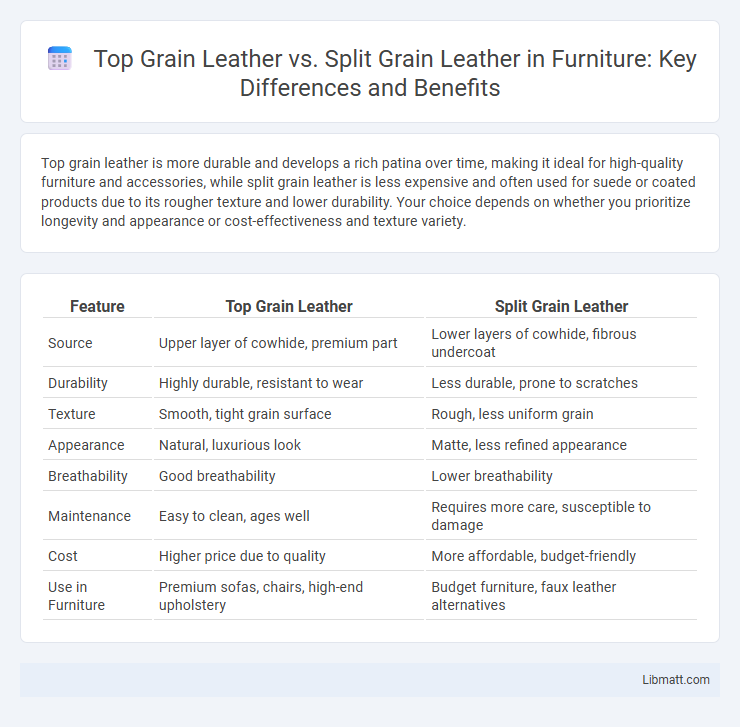Top grain leather is more durable and develops a rich patina over time, making it ideal for high-quality furniture and accessories, while split grain leather is less expensive and often used for suede or coated products due to its rougher texture and lower durability. Your choice depends on whether you prioritize longevity and appearance or cost-effectiveness and texture variety.
Table of Comparison
| Feature | Top Grain Leather | Split Grain Leather |
|---|---|---|
| Source | Upper layer of cowhide, premium part | Lower layers of cowhide, fibrous undercoat |
| Durability | Highly durable, resistant to wear | Less durable, prone to scratches |
| Texture | Smooth, tight grain surface | Rough, less uniform grain |
| Appearance | Natural, luxurious look | Matte, less refined appearance |
| Breathability | Good breathability | Lower breathability |
| Maintenance | Easy to clean, ages well | Requires more care, susceptible to damage |
| Cost | Higher price due to quality | More affordable, budget-friendly |
| Use in Furniture | Premium sofas, chairs, high-end upholstery | Budget furniture, faux leather alternatives |
Introduction to Top Grain and Split Grain Leather
Top grain leather is the upper layer of the hide, known for its durability, smooth texture, and natural grain pattern, making it a premium choice for high-quality leather products. Split grain leather, derived from the lower layers of the hide, is less durable and often treated or embossed to mimic top grain leather's appearance, resulting in a more affordable option. Understanding the structural differences highlights why top grain leather offers superior strength and aesthetic appeal compared to split grain leather.
What is Top Grain Leather?
Top grain leather refers to the uppermost layer of a hide that has been sanded and refinished to remove imperfections, offering a smooth, durable surface with a consistent texture. This leather type maintains much of the hide's original strength and natural grain, making it a premium choice for high-quality furniture, bags, and accessories. Understanding the qualities of top grain leather helps you select products that balance durability with a refined appearance.
What is Split Grain Leather?
Split grain leather is derived from the fibrous part of the hide left after the top grain has been separated, offering a more affordable alternative to premium leather. It has a rougher texture and is often used for suede or coated with a finish to mimic the appearance of top grain leather. Understanding this distinction helps you choose durable leather products tailored to your needs and budget.
Manufacturing Process: Top Grain vs Split Grain
Top grain leather is crafted from the outer layer of the hide, undergoing a process where the surface is sanded and refinished to create a smooth, durable finish, preserving the natural grain. Split grain leather, sourced from the fibrous underside of the hide, is typically embossed to imitate the appearance of top grain but lacks the same texture and strength due to its layered origin. Understanding the manufacturing process helps you choose between the superior durability and natural look of top grain or the more affordable but less resilient split grain leather.
Durability Comparison
Top grain leather boasts superior durability due to its dense, intact fibrous structure, making it more resistant to wear and tear compared to split grain leather, which is derived from the lower layers of the hide and lacks the same strength. Split grain leather tends to be more prone to scratches and less resilient over time as it doesn't have the natural protective grain layer found in top grain leather. Choosing top grain leather for your products ensures longer-lasting performance and greater resistance to damage in everyday use.
Appearance and Texture Differences
Top grain leather boasts a smooth, refined surface with natural grain patterns visible, offering a luxurious and supple feel. Split grain leather, derived from the lower layers of the hide, has a rougher texture and often requires embossing to mimic the appearance of full grain. You can expect top grain leather to provide a more polished and durable finish, while split grain leather tends to be less uniform and less resistant to wear.
Breathability and Comfort
Top grain leather offers superior breathability and comfort due to its intact surface grain, allowing better air circulation and moisture absorption. Split grain leather, derived from the lower layers of the hide, tends to be less breathable and can feel stiffer or less comfortable against the skin. Consumers seeking durable, breathable, and comfortable leather products typically prefer top grain leather over split grain leather.
Cost and Affordability
Top grain leather is generally more expensive than split grain leather due to its higher quality and durability, making it a preferred choice for premium products. Split grain leather is more affordable, as it is made from the lower layers of the hide and often undergoes processing to mimic top grain appearance. Cost-conscious consumers often select split grain leather for budget-friendly options without sacrificing the genuine leather look.
Best Uses and Applications
Top grain leather offers superior durability and a smooth finish, making it ideal for high-quality furniture, handbags, and apparel where appearance and longevity matter most. Split grain leather, derived from the lower layers of the hide, is often used in suede products, upholstery, and budget-friendly accessories due to its softer texture but lower resistance to wear. Your choice depends on whether you prioritize toughness and refined look (top grain) or cost-effectiveness and softer feel (split grain).
Which Leather is Right for You?
Top grain leather offers superior durability and a smooth finish, making it ideal for high-quality furniture and accessories that require longevity and a refined appearance. Split grain leather, derived from the lower layers of the hide, is more affordable but less durable, suited for budget-conscious purchases such as casual footwear and upholstery. Choosing between top grain and split grain leather depends on balancing cost, durability, and aesthetic preferences to match specific lifestyle needs.
Top grain leather vs split grain leather Infographic

 libmatt.com
libmatt.com